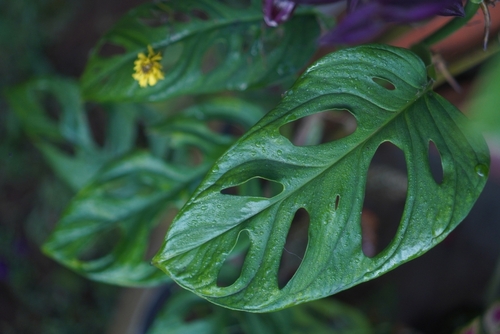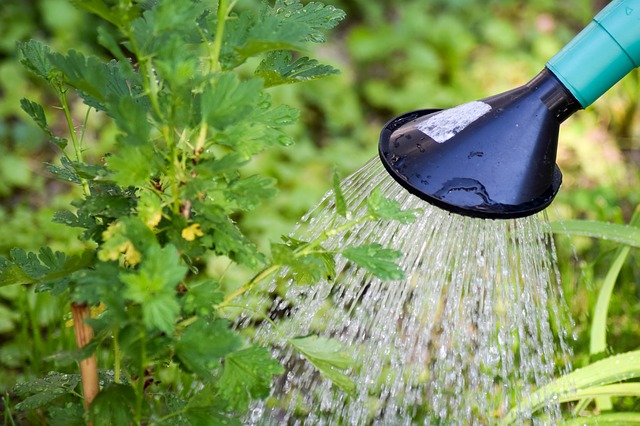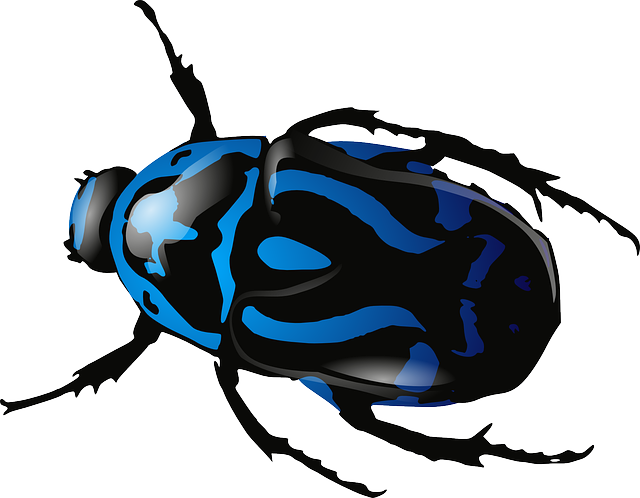Leaves with holes mean a sick plant right? Not always! The Monstera lechleriana is like an older brother to the Swiss cheese plant (Monstera adansonii).
It is a rare plant with even rarer variegations, perfect for any collector. If you are a fan of big leaves with eerie holes, the Monstera lechleriana is the go-to plant for you. Despite its unique appearance and rare variegations, Monstera lechleriana is a hardy and resilient plant, making it a great choice for both experienced collectors and those just starting out. What makes this plant so great? Find out below!
What is a Monstera Lechleriana Plant?
Monstera Lechleriana shares many of its characteristics with its other cousins, Monstera adansonii and Monstera deliciosa. They are all similar to each other in that they all have leaves with holes in them.
They are all relatively rare species of plants and are epiphytes, meaning they like to lean on other plants to grow and expand.
What sets Monstera lechleriana apart from its cousins is that it has thicker leaves with fewer holes. While it does not like direct sunlight and sudden temperature swings similar to the Swiss-cheese plant. It has different fertilization, growth habits, water needs, and foliage compared to others.
The lechleriana has fewer holes in its leaves at a young age compared to adansonii. Its leaves are more round while the adansonii has long holes.
Both love and need water but the lechleriana is harder than its delicate cousin. Monstera lechleriana loves humid climates with good drainage and is easier to grow compared to other Monstera plants.
Origin and Classification
Monstera (meaning monster in Latin) is a genus of the arum family, Araceae. There are 49 species and 6 infraspecific named plants within the genus Monstera. Monstera plants are named after monsters because of the naturally occurring holes that the members of the genus develop. The lechleriana is a Monstera plant native to Bolivia, Panama, Ecuador, Peru, and Venezuela but can grow in any humid environment.
Features of Monstera Lechleriana

The Monstera lechleriana loves a humid environment and doesn’t like direct sunlight. It is an evergreen plant with a slow rate of growth. It has large leaves when grown in its natural habitat but requires perfect conditions to grow that much in size as a houseplant
1. Height
The lechleriana is a low trunk climber epiphyte and in the wild, it can grow 23ft long. As a houseplant, however, you need to provide it with room to grow and climb. Typically, it will grow 4-6 feet high if provided with the climbing space. Still, if you grow it outdoors under the right conditions, it can grow even taller.
2. Fruits and Flowers
Monstera plants rarely flower when grown under cultivation. Since it is a medium to slow-growing plant, it usually takes 6-8 years to flower when it is in its natural habitat. The lechleriana flower has a pale yellow or creamy color.
Similar to its cousin Monstera, the flowers have white or light yellow spathe near the spadix. To touch, the flowers are leathery and thick with flat green stalks. The stalk has a white base and is about 7.8-15.7 inches long. A Monstera lechleriana fruit is creamy or yellow and has a cluster of fruits like berries with brown seeds.
3. Special uses and toxicity
The Monstera plants have been used to make medicines throughout history. But it is also toxic to both humans and house animals. It should be kept out of reach from children and animals because Monstera contains Calcium Oxalate crystals that are toxic to touch and consumption.
Touching the plant with bare skin can lead to irritation, itch, rashes, and stinging. Consuming the plant on the other hand can cause nausea, throat burning, vomiting, drooling, diarrhea, and difficulty swallowing.
4. Variegation
Monstera variegations are very rare. It is estimated that only 1 plant per 100,000 Monsteras develops variegation. The rarity of these variegations has led to rare plant collectors paying good money for them. You can sell a variegated Lechleriana for at least $1,000 in the right marketplace and possibly more in some places.
Lechleriana variegation has white coloring on the edges or below the leaves of the plant. Your Monstera might begin showing variegated leaves after a few years as it tends to take a while to bloom in some plants.
Basic care for Monstera Lechleriana
While its cousin Monstera adansonii is picky about its growing conditions. The lechleriana is relatively hardy and easier to grow. Still, it needs some care to properly flourish. Here are the basics you will need to keep in mind.
1. Size and Growth
The Monstera lechleriana is a slow-growing plant and takes years to grow to large sizes. Typical adult leaves are 30-47 inches (2.5ft – 3.9ft) long and 14-28inches (1.1ft – 2.3ft) wide. Lechleriana grown outside of its habitat require perfect conditions to achieve this size. The lechleriana grows during the summer and spring periods and hibernates through autumn and winter.
2. Light Requirements
Monstera Lechleriana requires a decent amount of bright indirect sunlight. Lechleriana in the wild grows in the shades of large trees. The lechleriana thrives on the filtered light from the canopy of the tree. Direct exposure to sunlight can quickly burn the foliage and ruin the plant.
3. Water Requirements

The hardy lechleriana loves water and thrives well with it. But that does not mean that it is immune to overwatering. Usually, you should water the plant every few days or a week during its growth time during spring and summer. Be careful not to overwater it, wait for the first inch or two of soil to dry before watering again. If the soil is not dry, it means the lechleriana has enough water for now.
4. Soil Requirements
Monstera plants love moist soils rich with nutrients and high in organic matter. The soil should be aerated and well-drained with neutral to slightly acidic potting. The Monstera lechleriana is a hardy plant that will grow even in sub-optimal conditions. But you should keep it away from heavily or poorly drained potting mixes as it increases the risk of developing root rot. Get a good potting soil for a healthy plant.
5. Sunlight Requirements
The low intensity of indirect light will stunt the growth of your Monstera lechleriana while direct light will burn the leaves and make them pale. The lechleriana can be grown in the shade as long as some indirect light reaches it. You can put them next to your window as long as you use blinds or 40% shade cloth.
6. Temperature and Humidity
Monstera lechleriana grows between 12.7°C to 26.7°C (55°F-80°F) and can bear slightly higher temperatures without much problem. Lower temperature will also slow their growth and they do not like cold or hot drafts so don’t place them near cooling or heating vents.
Sudden temperature swings will stunt their growth and can spoil the plant very quickly. Do not leave the plant outdoors if the temperature falls below 10°C, as it will stop their growth.
7. Drought and Disease resistance
Lechleriana likes to be watered, as long as it is not overwatered. In case of drought, a dehydrated Monstera lechleriana plant’s leaves will begin to curl and wilt.
As far as diseases are concerned, most diseases that affect lechleriana stem from the sun, temperature swings, water problems, or lack of nutrients. As such, it is a hardy plant and does not succumb to diseases easily if properly cared for.
8. Fertilizing
Aroids like lechleriana need a medium dose of fertilizer to grow quickly. You should fertilize the plant during spring and summer to help them maintain their growth. They only need to be fed once a month during their growing months and should not be fed during their fall or winters.
9. Potting and Repotting
Since this Monstera does not grow very quickly, it only needs to be repotted every 2-3 years. You need to report your plant when you notice the roots growing from the drainage holes. Yellowing and curling of leaves might occur if the plant is not repotted in time. The best time to repot a lechleriana is in springs to allow it to re-establish itself through the growth period.
10. Pruning Requirements

Using sterilized pruning shears, you can cut off the damaged, dead or diseased leaves. Doing so will prevent pests and give the lechleriana more room to grow. You can prune them during spring and summer to control their growth and promote branching.
How to Propagate Monstera Lechleriana
To propagate a Monstera lechleriana, you will first need the following things
Propagation container
Sterilized pruning shears or knife
Potting mix
You can also prepare some rooting hormones to increase the rate of success but it is optional. Once you’re done with the preparation, here’s how you can propagate your aroid.
Step 1
Prepare the potting mix by pouring water into the propagating mix until excess water starts coming out of the drainage holes.
Step 2
Cut off a matured stem with two or more nodes with your pruning shears. Make sure to cut just below the lower node to make replanting easy.
Step 3
Remove the lower leaves from the cut stem to promote growth but leave the upper ones intact. Prune any dead or diseased leaves away as well.
Step 4
Optional step, you can apply some rooting hormone to the part of the stem to be buried. This will increase the chances of successful rooting and growth.
Step 5
Create a small hole in your potting mix and plant your stem in it. Make sure to cover at least 2 nodes to ensure regrowth.
Step 6
Tamp the soil to ensure that the cutting stays upright, sprinkle some water on the cutting, and place it in bright indirect light.
Step 7
Mist the cutting often and ensure it stays moist. Placing the cutting in a humid environment will make it grow faster.
Common Problems Caring for Monstera Lechleriana
When raising plants, it is common to run into some problems. Here’s a list of common problems you might face when caring for your Monstera lechleriana and how to deal with them.
1. Pests

Common pests that might infest the lechleriana are spider mites and aphids. These are common among outdoor grown plants. Webbing, black sooty molds, and honeydew are some indicators of pests. If you notice yellowing of leaves, unnatural holes, and stunted growth on your lechleriana, you have a pest problem.
You can hose your plant to get rid of the pests or you can wipe the plant with rubbing alcohol. Moreover, you can also use indoor insecticides to get rid of pests.
2. Root rot
Root rot is the most common lechleriana problem, it occurs when the plant is overwatered. Yellow leaves, wilting, mushy stems at the base, and black spots on leaves are signs of root rot. Mild root rot can be cured by repotting however severe root rot is fatal to your plant.
When repotting your lechleriana, make sure to cut away any black or brown roots to prevent the root rot from returning. Also, get rid of the old potting mix as it is now useless.
3. Yellowing leaves
Yellowing leaves are a sign of overwatering a lechleriana. Yellow leaves can also occur if there is too little light, lack of nutrients, temperature swings, or dehydration. Infestations also lead to yellow leaves and it can be hard to find the exact cause of the problem.
It is common for old leaves to become yellow and drop, if there is mass yellowing, you should ensure that all the basic needs of the lechleriana have been fulfilled. You can refer to the ‘Basic needs’ section for a quick checklist.
4. Curling leaves
Monstera lechleriana leaves curl during the lack of water. Apart from dehydration issues that can prevent water absorption (soil salinity) can be the problem. Root rot, heat stress, pests, and salinity of the soil can be the cause of this.
Repotting the plant in an acidic to neutral mix can fix most of the problems, you should be on the lookout for root rot during the repotting process. If your plant does not have the ideal temperature to grow or is affected by pests, you should move it indoors and spray it with indoor insecticides.
Learn more about plant types: Alocasia Jacklyn
Outro
The Monstera lechleriana is a rare plant with even rarer variegation. Its large leaves with peculiar holes can be an excellent addition to any plant collector’s collection.
It is a hardy and slow-growing plant that can produce variegations as late as 8 years later. It does not produce fruit or flowers when cultivated but it is a great plant for anyone who likes plants similar to Swiss cheese plants.
Frequently Asked Questions
Is Monstera Lechleriana Rare?
Yes, the lechleriana only grows in humid and slightly warm conditions. It is an uncommon plant outside the South American region and it is very popular in homes. Variegated lechleriana occurs in 1 in 100,000 Monstera lechleriana.
How do you Identify Monstera Lechleriana?
The lechleriana has large leaves with few holes. Unlike other Monstera plants, the lechleriana has more uniform leaves with smaller holes near the middle vein. It is also more resilient to environmental factors than Monstera adansonii and Monstera deliciosa.
How to tell Lechleriana and Adansonii apart?
Monstera Adansonii has smaller and thinner leaves while the lechleriana has thicker and larger leaves. Even at a young age, the lechleriana will have larger leaves with round holes whereas the adansonii will have long holes that shoot outwards.

Hey, I’m Lisa and I’ve been an avid gardener for over 30 years. I love writing, talking and living in the garden! Feel free to connect with me on my socials below
